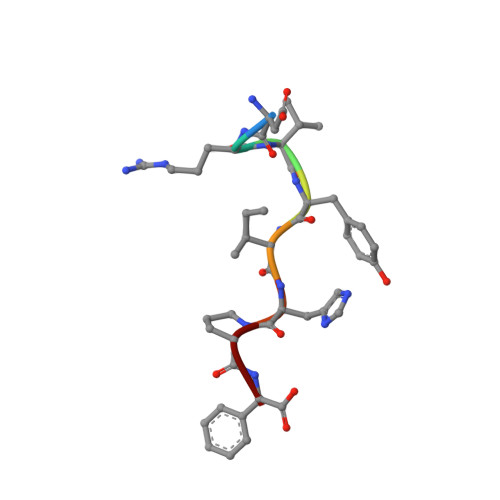Comparison of the solution structures of angiotensin I & II. Implication for structure-function relationship.
Spyroulias, G.A., Nikolakopoulou, P., Tzakos, A., Gerothanassis, I.P., Magafa, V., Manessi-Zoupa, E., Cordopatis, P.(2003) Eur J Biochem 270: 2163-2173
- PubMed: 12752436
- DOI: https://doi.org/10.1046/j.1432-1033.2003.03573.x
- Primary Citation of Related Structures:
1N9U, 1N9V - PubMed Abstract:
Conformational analysis of angiotensin I (AI) and II (AII) peptides has been performed through 2D 1H-NMR spectroscopy in dimethylsulfoxide and 2,2,2-trifluoroethanol/H2O. The solution structural models of AI and AII have been determined in dimethylsulfoxide using NOE distance and 3JHNHalpha coupling constants. Finally, the AI family of models resulting from restrained energy minimization (REM) refinement, exhibits pairwise rmsd values for the family ensemble 0.26 +/- 0.13 A, 1.05 +/- 0.23 A, for backbone and heavy atoms, respectively, and the distance penalty function is calculated at 0.075 +/- 0.006 A2. Comparable results have been afforded for AII ensemble (rmsd values 0.30 +/- 0.22 A, 1.38 +/- 0.48 A for backbone and heavy atoms, respectively; distance penalty function is 0.029 +/- 0.003 A2). The two peptides demonstrate similar N-terminal and different C-terminal conformation as a consequence of the presence/absence of the His9-Leu10 dipeptide, which plays an important role in the different biological function of the two peptides. Other conformational variations focused on the side-chain orientation of aromatic residues, which constitute a biologically relevant hydrophobic core and whose inter-residue contacts are strong in dimethylsulfoxide and are retained even in mixed organic-aqueous media. Detailed analysis of the peptide structural features attempts to elucidate the conformational role of the C-terminal dipeptide to the different binding affinity of AI and AII towards the AT1 receptor and sets the basis for understanding the factors that might govern free- or bound-depended AII structural differentiation.
Organizational Affiliation:
Department of Pharmacy, University of Patras, Greece. G.A.Spyroulias@upatras.gr














